Comparing Clone Wars Cartoons: How to Treat the Audience
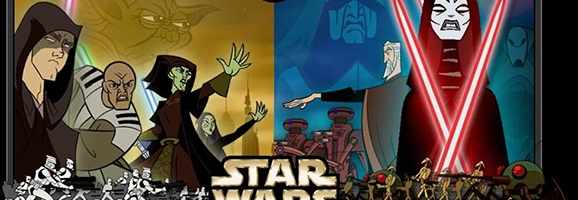
A long, long time ago, George Lucas was dismayed at the result of the first Star Wars film. “I made a kids film,” he said. He shouldn’t have worried; there’s nothing wrong with making a film that skewed younger. There’s no rule that says that something made for a younger audience has to be dumbed down. Look at Empire Strikes Back, the pinnacle of the franchise. There was comic relief with C-3PO and R2-D2, a funny psychic puppet and even screwball physical comedy aboard the fugitive Millennium Falcon. At the same time, though, there was a kind of darkness that the franchise hasn’t felt in a long time. Luke’s vision on Dagobah, the Han-in-carbonite cliffhanger and the duel between father and son all managed to be thematically rich examples of filmmaking that entered the cultural consciousness.
While Star Wars has arguably always targeted younger audiences, some attempts to reach kids have stood out more than others. The two animated series chronicling the Clone Wars, named Star Wars: Clone Wars and The Clone Wars, are prime examples. Both shows, made years apart, covered the same time period, the same kinds of stories and, usually, the same pool of characters. The differences in the shows are more telling than the similarities, though. While the first series was fluent in the visual and dramatic language made iconic by the original trilogy, the second series was marked by how it talked down to a younger audience.
The root of these differences can be attributed to the creators of the different programs. The first series was created in 2003 by Genndy Tartakovsky, of Samurai Jack fame. Despite garnering huge acclaim, Tartakovsky was not involved in the production of any further Star Wars material. Regarding the second series, George Lucas was credited as the creator, but it was Dave Filoni, the supervising director and executive producer of the series and the director of the 2008 film that kicked it off, who really gave the show its heart. Filoni’s response to the cancellation of The Clone Wars showcases Filoni’s passion for what really was his slice of the Star Wars universe.
Both of these men brought their unique set of skills to the table when crafting their respective takes on the Clone Wars. Each show had its own strengths and weaknesses in various regards, but when it came to storytelling, Tartakovsky proved that less is more. While Filoni’s series made everything explicit and detailed, Tartakovsky’s Clone Wars used restraint when portraying everything from combat to prophecy.
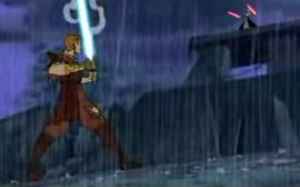
The Tartakovsky Saga
Tartakovsky’s series knew when and when not to employ dialogue. Take the extended duel between Anakin Skywalker and Asajj Ventress on Yavin 4. Nearly wordless, the sounds that are heard serve to frame the action and develop atmosphere. The whooshing through tree canopies and the sound of a lightsaber blade sizzling in the rain allowed the viewer to truly feel like they were in the jungle watching the two in combat. This careful use of sound ratchets up the tension in the duel, a conflict made all the more harrowing by the singular focus of the battle. The audience sees nothing else for the three episodes in which the duel occurs, and the conclusion really pays off. When Anakin lets out a scream of primal rage, it rings with meaning for both the character and the audience.
Atmosphere also came into play when Anakin’s dark future was tackled in the second season of Tartakovsky’s series. After interrupting a rite of passage ritual on the planet Nelvaan, Anakin is tasked by tribal shamans to find out why their planet is ailing. Obi-Wan sees this as a chance for Anakin to undergo the Jedi trial that his former apprentice never had to face: the Trial of the Spirit. Indeed, as Anakin enters the cave he senses to be the source of Nelvaan’s woes, he falls into a deep meditation. Cave paintings on the walls come to life, portraying a male warrior whose increasing power begins to swallow and destroy everything around him. As the rigid lines of paint swallow the cave, the face of Darth Vader forms on the wall, snapping Anakin out of the vision. Rather than disregarding this parallel of Anakin’s own growing power, or simply using the vision merely as a means to advance the plot, the Nelvaan arc ends with Anakin saving the planet from Separatist forces by succumbing to blind rage. It creates a bittersweet ending, for while Anakin saves the day, he finds himself one step closer to darkness, which comes a head in the events immediately following Tartakovsky’s series: the film Revenge of the Sith.
This bittersweet ending echoes the harshness felt in some of the darker moments of the Star Wars films. Indeed, none of the Star Wars films in either trilogy attempt to teach moral lessons in any obvious manner, and neither does Star Wars: Clone Wars. Tartakovsky spends more time with the characters, so all of the actions taken aren’t viewed from a moral lens, but through the haze of character motivation. Take the introduction of General Grievous in the final episode of the first season. There’s no overt message, no lessons, just the foreboding sense that war is hell. Even though the outnumbered Jedi say nearly nothing, the fear is palpable. When the Jedi Sha’a Gi breaks down, it’s not to further a moralistic agenda, it’s because he’s afraid, desperate and, ultimately, weak. These stark, frank depictions of minor characters are as real as it gets in a universe where worms live in asteroids.
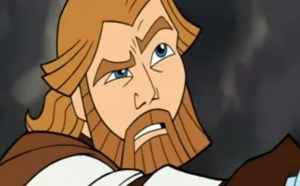
Because Tartakovsky’s series exercises such control over atmosphere and storytelling elements, moments of character shine through and become the most memorable moments of the series. These moments certainly set the series apart from Filoni’s take on the same material. Star Wars: Clone Wars took time for characters and wasn’t afraid to slow things down. Even in the midst of battle, small moments of calm punctuated chaotic melees. Even when the combat took hold, character moments still managed to shine through, such as Obi-Wan’s eyebrow-arching confusion while battling the Gen’dai bounty hunter Durge. By saying little and showing more, Tartakovsky’s series didn’t stop to say everything for younger viewers, and it certainly didn’t feel the need to make point-five past lightspeed as far as pacing was concerned. In this respect, Star Wars: Clone Wars stands near the top of the franchise’s food chain as far as quality is concerned.
The Filoni Saga
Contrast the duel on Yavin in Tartakovsky’s series to a battle between the same characters in a deleted scene from Filoni’s The Clone Wars film. Hardly the scene’s sole point of focus, the duel in the film is one of many things going on. As Anakin’s apprentice Ahsoka Tano jumps around killing droids and R2-D2 opens up a trap door, Ventress and Anakin cross blades and trade barbed dialogue. Certainly there are more things physically happening in this duel, but the rapid pacing of the scene robs it of meaning just to keep the plot hurdling along. Of course both duels had different goals, and the Filoni scene wasn’t trying to convey Anakin’s descent into darkness, but when handed the same general task of “have Anakin and Ventress fight,” the two shows took radically different turns.
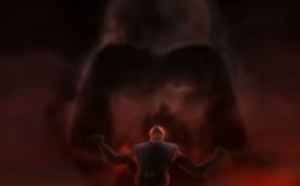
This isn’t to say that Filoni’s show never had moments of darkness. Anakin’s eventual fall to the dark side is tackled head on in the episode “Ghosts of Mortis.” While encountering the malevolent dark side incarnate known as the Son, Anakin receives a fragmented vision of his downfall. As dark clouds swirl around the young Jedi, visions of Obi-Wan Kenobi, Palpatine, and Padme cause Anakin to yell out in torment just before the smoky visage and iconic breathing of Darth Vader appear. As powerful and well-executed the scene was, though, the consequence of Anakin’s knowledge that he will be manipulated by the dark side leads him to, oddly, be manipulated by the dark side. The Son’s Father eventually breaks Anakin’s imprisonment by the dark side by erasing his memory, thus rendering the scene of Anakin’s vision to be pointless. Even when tackling the nature of destiny and the Force, Filoni’s series still put more emphasis on plot than on thematic exploration.
These two comparisons highlight the major storytelling divide between the two series. Where Filoni’s series was more plot driven and obvious, Tartakovsky’s show was more concerned with taking its time and conveying messages through more dynamic means. The plot-heavy focus of Filoni’s series, however, supported another aspect of The Clone Wars’ narrative structurethat set it even further apart from Tartakovsky’s vision: the inclusion of moral messages.
Filoni’s series feels much more like it was directed to children because of the lessons that many episodes tend to impart. Each episode begins with a short proverb, or moral, that tells the viewer what the message of the episode will be. From humility to teamwork, The Clone Wars usually sought to teach a worthwhile lesson amidst the carnage of war.
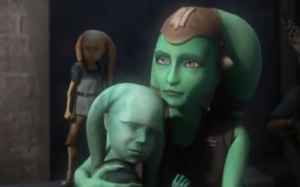
This approach was simultaneously appropriate and problematic in the episode “the Soft War.” The third of a four-episode arc, the plot follows Ahsoka training a band of rebels who seek to retake their home world of Onderon. In doing so, however, these rebels inevitably become branded as terrorists, drawing fear from the citizens of Onderon’s capital. The show goes to great lengths to explain how the rebels’ weapons only hurt droids and how the current regime is corrupt, if legitimate, but actions of the Jedi (aiding a group of rebels to overthrow a legally accepted and neutral regime) are hard to justify in simple moral terms. The opening proverb of “struggles often begin and end with the truth” refers to how the rebels must win the trust of the civilians, which is admirable, but it doesn’t address the complicated questions of terrorism and sovereignty that the episode raises.
What the murkiness of “The Soft War” illustrates is that attempts to be moralistic and didactic for the sake of a younger audience can backfire. By attempting to assign parables and lessons to a war, Filoni’s series does disservice to complex themes that are unfit for the show. There’s nothing wrong with a children’s show attempting to tackle heavier themes, but the overt moralizing in The Clone Wars tends to make grey issues seem black and white.
Not only does this approach gloss over complicated issues, it also causes the audience to see the characters’ actions differently. In the span of an episode, a character’s arc becomes more predictable due to the presence of the frontloaded moral message. In the episode “Lightsaber Lost,” Ahsoka loses her lightsaber and is forced to enlist the help of an older Jedi named Tera Sinube. Ahsoka is impatient and Sinube isn’t as fast as he used to be. The moral is “Easy isn’t always simple.” Given this information, it can be deduced that Ahsoka will learn to take her time and be more observant. The audience knows that Ahsoka will do this because that’s the moral, and thus all characters are seen not by how they would act as an individual, but how they will act in the context of a lesson. All of the character development is jammed into an arc that panders to a younger audience, teaching morals in a way that presumes story and character should take a back seat to an arbitrary message.
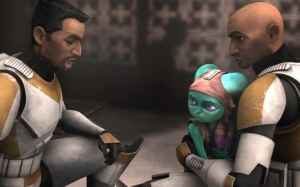
However, Filoni’s series is not bereft of strong character moments. Indeed, the episode “Innocents of Ryloth” examines a small slice of a larger battle wherein two clone troopers bond with a small Twi’lek child in a war-torn city. The language barrier between the clones and the child creates both light comedy and touching drama, and the relationship that two battle-hardened solders make with a child of conflict eclipses whatever background plot that the episode have.
Episodes like “Innocents of Ryloth,” though, are few and far between. Character-driven storytelling is rare in Filoni’s series, as arcs that are plot and message-heavy dominate the series. By focusing more on action and morals, though, Filoni allows the essence of the Clone Wars to slip through his fingers. Lots of things are happening and plenty is being said, but at the end of each episode (and even at the end of the series), there is little sense that Anakin Skywalker or Obi-Wan Kenobi or anyone else has changed significantly. Obi-Wan even got a love interest, but it mattered little to his development in the long run. By minimizing the character arcs and the potential for complicated storytelling, Filoni’s The Clone Wars asks little of its audience and just shows battle after battle, punctuated by the occasional gem of character.
Conclusion
The comparisons between the two series go on and on, but the point is clear. Tartakovsky’s Star Wars: Clone Wars didn’t treat the audience like children, instead using a sophisticated array of cinematic technique to convey complex themes without being blatant. Filoni’s Star Wars: The Clone Wars, while occasionally evoking interesting ideas and crafting genuinely moving scenes, was less confident in its younger audience and the show suffered for it. If these superficially similar programs give any indication, any show treats the audience like children, it limits itself and underestimates its audience, which is unfair for both the creative team behind the show and the people watching them. To paraphrase Yoda: “Judge them by their size, do not.”
What do you think? Leave a comment.
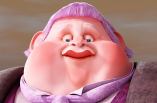

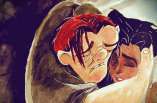








One thing that is really bothering me with the new “Clone Wars” is the fact that according to this (vastly superior) series Ventress dies at the hands of Anikin before becoming a Jedi Knight and before he got the scar on his eye. Yet she appears in the Clone Wars movie, where Anikin has the scar over his eye and is a Jedi Knight. Also another thing that really bothers me is WTF does Anikin have a padawan if he isn’t even a Jedi Master, wasn’t that one of the key plot points in ROTS was that he was the only non-master on the council. I know this is all fan bitching, but I just can’t help but feel slighted knowing that the POS new Clone Wars is going to go on for 100 episodes and Genndy’s Clone Wars only gets two hours. Genndy’s is easily the best thing to happen to Star Wars in the past two decades other than the Jedi Knight games.
You could see the non-Master comment in RotS as a way of saying Anakin is not a Jedi Master ‘currently.’ He was a Jedi Master and you can see that even in Filoni’s Clone Wars, leading up to Ahsoka ‘somehow’ leaving the Jedi Order whether by choice or death or whatever) is being built up towards.
The only problem i have with new show is how the droids and the clones act sometimes, its kind of annoying.
I feel like I am the only one who likes the later series more than the 2003 2D show… anyway what a great show but those Mandalore episodes from Season 3 were absolute stinkers. Pretty much every politics based episode sucked, especially compared to the awesomeness that was every single Maul/Ventress/Oppress/Talzin episode.
The Clone Wars was perfect… We saw all the carrier of ashoka… Fives…
These and so many other characters will always be up there with luke, leia, han, anakin, padme…
Clone Wars made us laught and made us cry…
Thank you mister Lucas… Thank you mister Filoni…
The Force will be with you always…
I was a Clone Wars doubter at first. The animation style and giving Anakin a padawan was really off putting. Now I can’t imagine SW without Clone Wars and Ahsoka.
I believe in Filoni and his team, and I’m really looking forward to Rebels. I know I won’t be making the mistake of missing out at the beginning of the series like I did wth Clone Wars.
Man I can wait for Rebels. Clone Wars made the prequel movies worth it, even if they weren’t as good as the original trilogy. I’ve been watching cartoons for over 30 years, and this one shot it’s way right up into my all time top 5 with such classics as Robotech, Transformers Generation 1, Batman the Animated Series, and the original Thundercats.
Clone Wars (2003) is stupid as hell. I mean say what you will about the new series, it can be tedious at times, but its never got so insane as this series had. This makes the Jedi look like GODS! This series shout render the entire OT null and void. I mean with Windu around they would NEVER get wiped out. This is why I prefer the new series: Dark, subtle, and character driven as opposed to Over the top, stylish and action driven.
Yeah bit over the top with Windu scenes on Dantooine
I prefer the 2003 style. I’d rather have that top-the-style then see some of my favorite characters been butchered all for the sake of plot armor on the Jedi/Republic side. Maul and Grievous are my main examples. Greivous turned into a incomptent buttmonkey and Maul begs for his life like a sniveling coward instead of dying with honor against palps. So yeah in my opinion 2008 is stupid as hell.
The first Clone Wars is excellent. I love it so much. I wish they could have made more episodes though…
Wow, so thankful for Lucas creating this universe but also so thankful that he no longer has anything to do with it anymore.
The clone episodes were my favorite. Fives and Rex were my favorite characters. When the clones had to take on that crooked Jedi (with TWO DOUBLE SABERS).. Woah. Really wish we had gotten to see more of them. And some closure with Ahsoka and Maul. They kinda just left that dangling, sadly.
Oh, and Maul was ridiculously awesome.
I think the show was at its best with episodes that didn’t focus on Jedi, because then other characters like Ventress (who had a few great solo episodes) were actually allowed to do stuff besides run away. Except political episodes. It’s safe to skip whenever you see Jar Jar or Padme.
Thanks for the article, perfect timing. I was just getting ready to start this series from the beginning.
Clone Wars was better than Episode 1,2 and 3 put together. It is such a great series it should be noticed more by the Star Wars fans.
It sounds goofy to say, but Lucas has lost touch with reality. Anakin and Ahsoka hiding under a box. Mutt swinging from tree to tree. Anything he touches including Star Wars and Indiana Jones he makes so unbelievable I cringe.
I loved The Clones Wars, and I’m looking forward to Rebels.
Dave Filoni knows how to satisfy Star Wars fans and his show 100% definitely did for me. It’s truly sad to see it go and to know there were more stories to be told and characters to explore but these things happen.
With Rebels paving it’s way this year I can only imagine the satisfaction that’ll be delivered once it has finally aired. Hopefully we’ll get a few nods back to The Clone Wars and maybe we’ll truly see what happens to Rex. One can only hope.
I like Filoni, It’s clear he understands what fan’s want. Clone Wars was one of the best cartoons I’ve ever seen.
I’m just upset it was cancelled, especially for Rebels, which kind of looks like a little kid show…
Dave Filoni has done great things for Star Wars. Can’t wait to see Rebels.
I wish we could kick start a season 7 just to wrap up maul (even though he’s becoming a comic) fett’s escape, echos apparent survival and more cad bane
I love things that are meant for children but don’t dumb things down to them. I think more filmmakers and writers in today’s world need to follow that logic again.
I believe that the Clone Wars are good for both adults and children. I know from experience, because my husband and I will have family time with our kids while watching these cartoons. There’s not many cartoons out there that I will allow my children to view. I’m actually entertained by the story lines and enjoy watching them. Maybe it’s because I watched the original movies in the movie theatre as a kid and all of the prequels with my kids, but I do find it nice to be able to connect the dots between movies.
One really good fight in Filoni’s Star Wars is Darth Maul and Savage Opress vs. Darth Sidious. Filoni did what even Lucas could not. We really saw the full power of Palpatine and not a wild shriek in the middle of the fight.
I really appreciate this post. The 2003 Clone Wars series does NOT receive enough praise — it’s one of my favorite Star Wars cultural products ever.
General Grievous in that series is far more menacing than even in Revenge of the Sith. The animated series even explains WHY — Mace Windu Force-crushes Grievous’ chest plate thus making it hard for him to breathe (in the very first scene of Revenge of the Sith).
That is cross-platform storytelling at its best.
I think Filoni learned his lesson from The Clone Wars, because Rebels is a vastly superior show to what he worked on before.
Unlike The Clone Wars, Rebels is written pretty much entirely around the characters. It takes its time to let the characters develop and isn’t afraid to sacrifice action sequences for development. Thanks to this much needed change of pace from The Clone Wars, the characters actually mean something to the viewer, rather than just being clichéd blank slates.
Thanks for summing up the old 2003 series. While I have yet to actually experience the 3-D Clone Wars on the whole, I do think there are certain strengths to be found on in the more extended 3-D series where character development and themes can breathe. At the same time, I always loved the old series for its stark minimalism and non-moralizing nature. It was always about the “war is hell” experience.
What an excellent break down. I couldn’t agree more. I like the more recent Clone Wars series, however nothing compares TV Show wise to Gennedy Tartovski’s Clone Wars cartoon. I really do believe that captured the feeling of the Clone Wars in such a way, I felt like at times I was watching something special, unique and at times artistic. I adored the silence, and the way the Jedi’s seemed to be heroic Generals, yet mystical and mysterious warriors at the same time. I was utterly devastated as a young lad to see Gennedy was no longer working with the Clone Wars show, despite them clearly taking his art style as inspiration.
Just watching Samurai Jack, you can imagine how excellent he would be diving into a world like Star Wars. The little five minute episode with Kit Fisto fighting in the war on Mon Calamari, had me turn into an odd side character fanboy when it came to the Jedi’s. Somehow he made them feel as cool and as important as the main characters, despite having so little to do with the films.
I will say, The Clone Wars CGI Series did get much better as the seasons went on. I enjoyed how the animation improved ten fold, and the story did get darker. However I only wish they focused less on Anakin and Ahsoka, as Aksoka felt almost non-existent due to not even being mentioned in the films. Anakin also seemed very odd to me, so unlike his character from the movie. So light hearted, and most episodes seemed to have no conflict within him. This was something I felt Tartovski captured brilliantly in the Animated Cartoon. I’ll never forget the duel with Ventress, when he uses her lightsaber to bash her off the cliff, screaming as the red aura of the blade reflected on his face.. Gives me chills to this day.
This article isn’t really a comparison it’s singing the praises of 2003 while criticizing 2008 and pointing out lots of small flaws. Neither show is perfect but it is good to appreciate both as they are both great in different ways Tartakovsky’s showed us less is more and gave sophisticated moral lessons but Filoni’s provided us with good moral lessons but more explicitly. They both have strengths and weaknesses but we need to address both equally I think you should cherish the good things and get over the bad.
Except some of the bad SHOULDN’T be overlooked. Case in point how they butchered stape characters like Maul and Grievious. Greivious was such a badass in the 2003 cartoon but he turns to an incompetent buttmonkey who fails to kill a padawan multiple times. Maul turns to a pathetic creature who begs for his life after watching his brother murdered before his eyes instead of honoring him by dying with some damn dignity.
Nice little write up of the 2003 clone wars series.
Great article. Personally, I think the biggest mistreatment of the 2003 series is how at the very least the second season arc should really be considered essential to understanding “Revenge of the Sith,” especially considering it leads into the opening moments of that movie. Cartoon Network even aired the entire season the day RotS opened in theaters. The most convincing reason for this is General Grievous himself. For those who haven’t seen it: At the end of the season 2 finale, Grievous is lifting off with a captured Palpatine back to his ship when Mace Windu jumps in and confronts him. Grievous draws his 4 lightsabers, but Mace uses the Force to crush his midsection and incapacitate him while the ship lifts off. Grievous immediately starts coughing because of his injuries. Cut to the first time we see Grievous in the movies, and in the midst of his monologuing to Anakin and Obi-Wan he starts coughing for no reason, and continues to do so through the entire movie. Without the context of the cartoon, this seems like a complete non-sequitur and certainly not a characteristic of an imposing villain. I watched the cartoon as it aired on TV and especially the season 2 finale before going to see Episode III, and now I’m not sure why the elements that are so essential from the cartoon weren’t at least referenced in the film. When I introduced my girlfriend to Star Wars and we watched the entire series in order, I even had her watch the Tartakovsky cartoon in between Episodes II and III because I considered it so important to the continuity of the story.